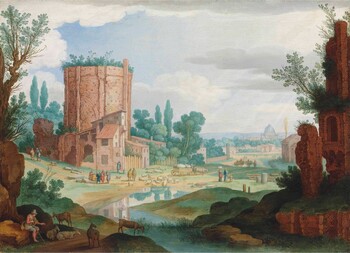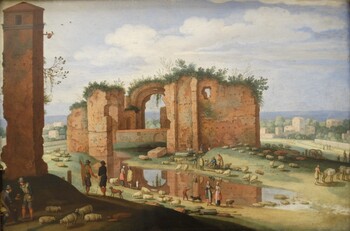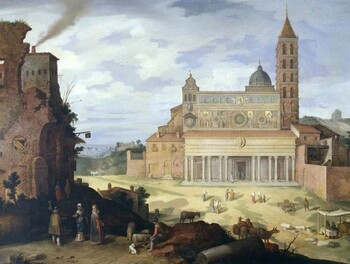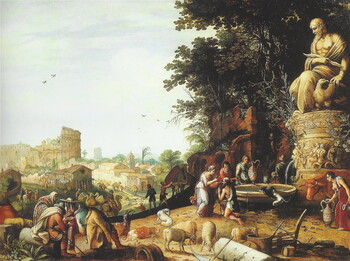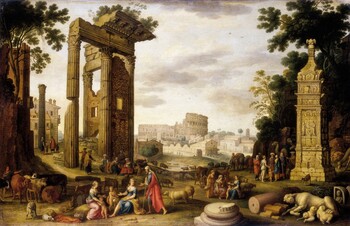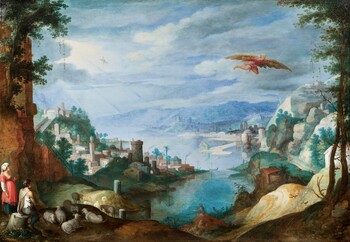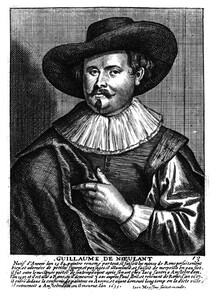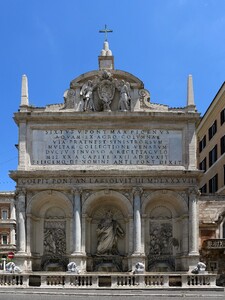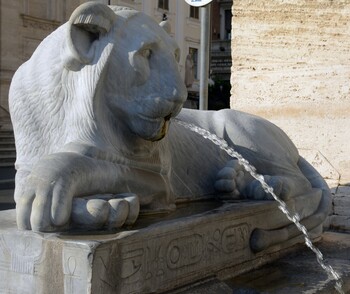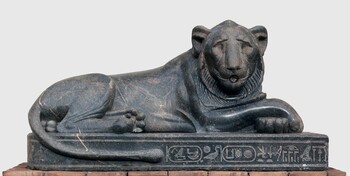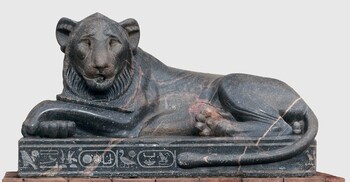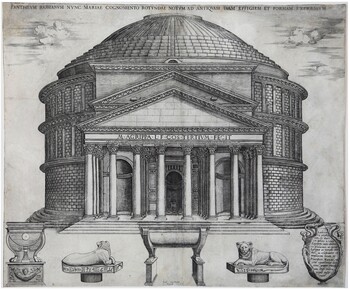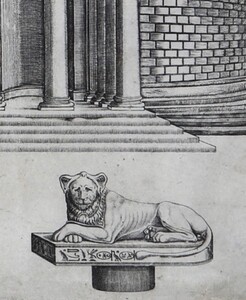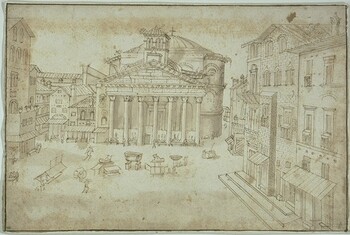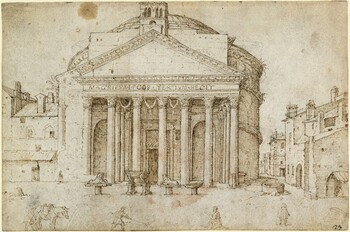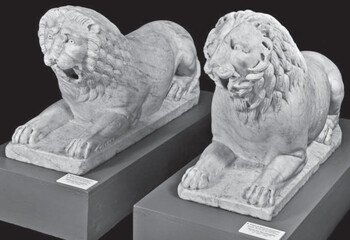8.800 €
A Roman landscape with Naomi and Ruth, Orpah stepping away
Oil on panel : 36,8 X47,4 cm
Unsigned
Frame : 51,à X 62,1 cm
In short
During the first years of the 17th century Willem van Nieulandt the Younger spent four years in Rome, studying under his uncle Willem the Elder and under the important landscape painter Paul Bril. This stay was decisive for his later development: their influence and the town views with Classical ruins that he saw here would inspire him during his complete career.
Our painting represents a scene from Jewish tradition and of the Old Testament: a foreign woman, Ruth, follows her mother-in-law, Naomi to Israel, and remains loyal to her new, Jewish religion. She is a convert who attaches herself to the values of Judaism and she is an ancestor of King David (his great-grandmother) and therefore also of Jesus Christ.
The monumental lion fountain at left is inspired by one of a pair of ancient Egyptian statues brought to Rome during Antiquity. In the 15th century they stood in front of the Pantheon, in the 16th century they were incorporated in a monumental fountain, the Fontana dell’Acqua Felice, where our painter saw them at the start of the 17th century during his stay in Rome.
About Willem van Nieulandt II
Flemish painter, also active as a well-known playwright, and as a poet and engraver
Antwerp 1584 – 1635 Amsterdam
History and landscape painter: specialist in biblical and mythological subjects set against a Roman backdrop with ancient ruins and statues.
His first name is often spelt Guilliam, as he signed his paintings this way.
Son of the Antwerp quill merchant (‘penverkoper’) Adriaen van Nieulandt. Following the conquest of Antwerp by Spanish, thus Catholic troops in 1585, he moved with his family in 1589 to Amsterdam.
Willem II studied painting in Amsterdam under the Flemish painter Jacob Savery I (circa 1565 – 1603).
He left Amsterdam in the autumn of 1601 for Rome. From 1601 until 1603 he worked and studied here in the workshop of his uncle, the painter Willem van Nieulandt I (1560 – 1626) who had arrived in Rome in 1596 and remained here until his death in 1626. He was known in Italy as Guglielmo Terranova. Inspired by this Italian first name our painter probably started writing his as Guilliam. In his testament made in 1626 in Rome Willem I left his house in Antwerp to our painter.
Karel van Mander mentions that in 1604 Willem II was a disciple of the famous Flemish landscape painter Paulus Bril (1554 – 1626) in Rome. This stay in Rome, combined with the numerous drawings that he made, laid the foundations for the architectural motifs that he would paint after his return in the Low Countries.
That same year, 1604, Willem II returned to Amsterdam, got married in February 1606 and immediately left for his birthplace Antwerp. Here he divided his attention between several branches of the Arts: painting, engraving, poetry and playwriting. His Antwerp contemporaries considered him the most successful author of tragedies, which were based on a Christian-Stoic philosophy and were characterized by a great purity of language. Van Nieulandt enjoyed, just as his great example the Roman author Seneca, to include grim, gruesome scenes in the six plays that he published in Antwerp. Willem was a member of the Antwerp Chamber of Rhetoric ‘de Olyftack’ from 1613 to 1621. That year he transferred to its rival, ‘de Violieren’, until 1629.
In 1628 his daughter Constantia married the Antwerp still-life painter Adriaen van Utrecht.
Willem II left for Amsterdam after May 1629. In 1635 he published his last, seventh, tragedy, drew up his will (24/10) and died shortly after.
Willem’s brother, Adriaen van Nieulandt I (circa 1586 – 1658), was a history and still life painter, who had been a pupil in Amsterdam of Pieter Isaacsz and of Frans Badens. He was also active as art dealer. He seems to have stayed in Amsterdam, although a single work from 1612 is inscribed “Antwerpen”.
About the subject of our painting
The Biblical Story of Naomi and Ruth is a symbol of abiding loyalty and devotion. At the end God rewards a foreign woman who attaches herself to the values of Judaism.
At a time of great famine in Bethlehem a man fled with his wife Naomi and their two sons from Judea to settle in Moab (present-day Jordan). After her husband passed away, both sons of Naomi married native women, Orpah and Ruth. After both her sons have died Naomi decided to return to Israel, to Bethlehem and she asked her daughters-in-law to return to their local families.
Orpah does so, but Ruth refuses to leave Naomi, declaring (Ruth 1:16 –17), “Where you go, I will go; where you lodge, I will lodge; your people shall be my people, and your God my God. Where you die, I will die —there will I be buried.” Ruth accompanies Naomi to Bethlehem and later marries Boaz, a distant relative of her late father-in-law. Their grandson will be the father of (King) David, whose genealogy would come to Joseph and thus to Jesus Christ.
About the lion fountain at left
This monumental lion fountain is one of a pair of ancient Egyptian statues that originally stood in front of the Pantheon. When Willem van Nieulandt the Younger lived in Rome at the very start of the 17th century both lion statues had already been integrated into the Acqua Felice Fountain with two other, but Medieval lion statues that originally stood on both sides of the side entrance of St. John in Lateran (San Giovanni in Laterano).
During the Imperial Age obelisks and colossal statues were carried in numbers from Egypt to decorate Rome and the imperial villa of Emperor Hadrian in Tivoli. These two Egyptian lions originally stood in a shrine dedicated to Toth in Hermopolis Parva, in Northern Egypt, in the Delta. That small temple had been erected under the reign of Pharaoh Nectanebo II (360 – 343 BC).
It is uncertain where these Egyptian lions originally stood in Ancient Rome: already in front of the Pantheon or close by to it, in the Temple of the Egyptian goddess Isis or in the Baths of Nero. This pair of Egyptian lions was discovered during the reign of Pope Eugene IV (1431 – 1447) in the 15th century. A century later, during the reign of Pope Clemens VII (1523 – 1534) they were placed on two low columns in front of the Pantheon. Half a century later they were integrated into the Fontana dell’Acqua Felice (1585/1588), which was designed by Domenico Fontana for Pope Sixtus V.
Under Pope Gregory XVI (1831 – 1846) the four lion statues of the Fountain were substituted in 1839 by copies sculpted by Adamo Tadolini. Tadolini actually only copied twice the two Egyptian granite lions, so that the general aspect would look much more uniform. Originally the Fountain was decorated with the two Egyptian granite lions and two Medieval marble lions from St John in Lateran.
The pair of Egyptian granite lions was integrated in the Vatican, in the Gregorian Egyptian Museum. It stands today under the monumental pinecone. The Medieval marble pair of lions was taken to the Quirinal Palace until 1911. That pair is thought to be currently in the Pietro Canonica Museum near the Villa Borghese.
Why should you buy this painting?
Because, although fictitious, it perfectly catches the atmosphere of Rome at the very start of the 17th century: a small town filled with scattered ancient Roman ruins and statues.

